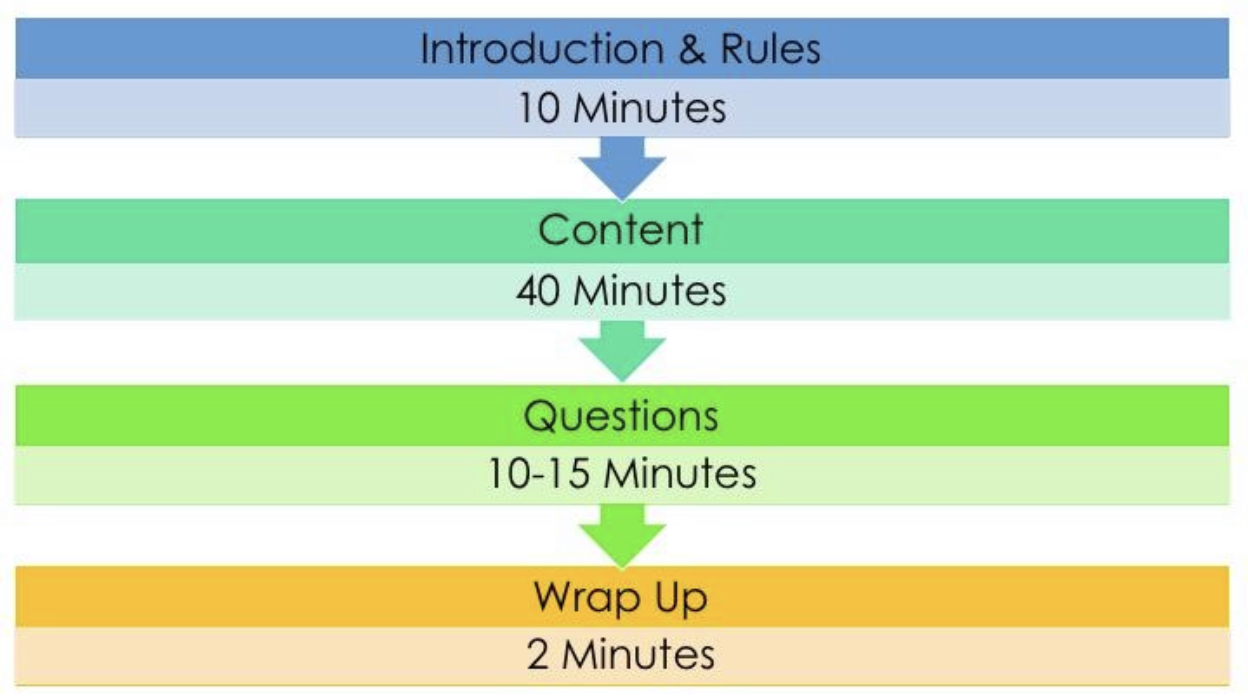Module 7: Planning Your Webinar
To host a successful webinar, thorough planning is crucial.
Topic
Just like with workshops, choose a high value topic for your webinar. If you’re running a webinar for prospects, the best case is to offer a teaser, lite version, or sampler of what you offer elsewhere.
If you’re offering webinars to customers only, choose topics that are relevant to your programs and services and which will help them improve the results they get. Your webinar can be for training or introducing deeper features for clients who have already made a purchase.
Another option is to partner with a client to run a webinar focused on a success story of how their usage of your product or service transformed their business. Be sure to include plenty of takeaways so that participants can learn something practical. You could frame it as how this story can help the participants get the same results.
Agenda
Make sure there is a clear agenda for your webinar. Plan the amount of time each section will take and stick to your schedule. Common sections for webinars include:
- Introduction and rules. Establish yourself as an authority in your market and establish the rules for the session. Depending on the platform you’re using, your webinar tools have different features for participation. Explain to participants how to use these features and lay down ground rules.
For example, during the webinar participants are muted by default. When a participant wants to ask a question, they should unmute, state their name, and then ask their question. You can use a chat pod for any questions during the webinar. Another example is that you might save questions for a designated part of the session.
- Content. The content should include your core message and the most relevant information to your audience. This is the majority of your webinar.
- Questions. This is time set aside for participants to ask questions. Depending on the length of your webinar, save aside at least a quarter of the time for questions.
- Wrap up. At the end of the webinar, summarize what you’ve taught, explain next steps, and tell participants how they can get more help. This is also when you would do any promotion portion, if you’re selling something.
Audience Size
How many people do you want to have at your webinar? The virtual aspect allows you to invite participants with no limitation on seating and space other than the limits set by your webinar platform plan. However, the actual turnout rate for webinars is around 30%. It’s easier in a virtual situation for people to sign up and then not show up. As this is the case, plan on inviting 3-4 times the number who you actually expect to attend.
There’s a noticeable difference between small groups of under 20 people and larger groups of over 20. Smaller webinars allow you to get more personal and it allows more possibility for engagement. It’s harder to have deep engagement with large groups. For larger groups, you might consider using holding the same webinar multiple times to divide up the groups. Larger webinars will involve more presentation time, and you’ll have to use surveys or other ways to gather data and feedback.
Audience Mix
While you might be aiming for new prospects, don’t forget about your existing client base as well. Webinars offer a great way to deepen your relationship with existing buyers. You can use a webinar to present new topics of interest to them. Customer-exclusive webinars make excellent bonuses for a membership site or for VIP customers.
Invitations
The best practice for inviting people to your webinar is to send an invitation with a registration link. This makes it easy for people to join and also offers you tracking data. You can even ask people to reply to the invite by telling you their biggest questions after they’ve registered. That way, you will know in advance how to give value, address concerns, and drive engagement.
You can also use a direct calendar invitation with the webinar URL. This allows you to monitor acceptance rates through your calendar tool.
Here are some of the best practices for sending invitations:
- In addition to sending the initial invitation, send reminder emails so that people who signed up don’t forget. Send at least one reminder the day before the webinar and again one hour before.
- Promote your webinar on social media and include links wherever possible to make it easy for people to find out more or sign up.
- Follow up after your webinar with a summary email if possible, including a link to a recording of the webinar or a text transcript.
- Track all data regarding the webinar, such as click through rates and attendance rates.
- Follow up with leads afterward with the aim of converting them.
Todd McCall
Instructor
I help practices who are marketing professional services get the attention they deserve by developing an online presence that converts visitors into clients.
Pricing Information
Ready to move forward? We have pricing options that range from full access membership to a la carte courses.
Membership Information
Membership in Coffee Break University has its benefits. Learn more about what our Power Practice Network has to offer.

